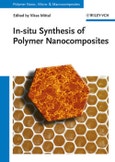The book series "Polymer Nano-, Micro- and Macrocomposites" provides complete and comprehensive information on all important
aspects of polymer composite research and development, including, but not limited to synthesis, filler modification, modeling, characterization as well as application and commercialization issues. Each book focuses on a particular topic and gives a balanced in-depth overview of the respective subfi eld of polymer composite science and its relation to industrial applications. With the books the readers obtain dedicated resources with information relevant to their research, thereby helping to save time and money.
In-situ intercalative polymerization in the presence of filler provides distinct advantages when compared to other nanocomposite synthesis
techniques including the possibility to polymerize a large range of thermoplastic and thermosetting polymers, improved handling of gaseous
or liquid monomers or high pressure polymerization and improved control of heat of polymerization. This volume aims to highlight these
advantages of the generation of polymer nanocomposites with a large spectrum of polymer matrices. Following an overview of the synthesis
methodologies, the text goes on to discuss the most relevant polymer materials, including polyamides, polyolefi nes, polyacrylates, polyethylenes, polyurethanes, polyesters and polyepoxides.
aspects of polymer composite research and development, including, but not limited to synthesis, filler modification, modeling, characterization as well as application and commercialization issues. Each book focuses on a particular topic and gives a balanced in-depth overview of the respective subfi eld of polymer composite science and its relation to industrial applications. With the books the readers obtain dedicated resources with information relevant to their research, thereby helping to save time and money.
In-situ intercalative polymerization in the presence of filler provides distinct advantages when compared to other nanocomposite synthesis
techniques including the possibility to polymerize a large range of thermoplastic and thermosetting polymers, improved handling of gaseous
or liquid monomers or high pressure polymerization and improved control of heat of polymerization. This volume aims to highlight these
advantages of the generation of polymer nanocomposites with a large spectrum of polymer matrices. Following an overview of the synthesis
methodologies, the text goes on to discuss the most relevant polymer materials, including polyamides, polyolefi nes, polyacrylates, polyethylenes, polyurethanes, polyesters and polyepoxides.
Table of Contents
PrefaceIN-SITU SYNTHESIS OF POLYMER NANOCOMPOSITES
Introduction
Synthesis Methods
In-situ Synthesis of Polymer Nanocomposites
POLYAMIDE NANOCOMPOSITES BY IN-SITU POLYMERIZATION
Introduction
Manufacturing Processes of Commercially Important Polyamides
Conclusions
POLYOLEFIN-CLAY NANOCOMPOSITES BY IN-SITU POLYMERIZATION
Introduction
Clays
In-situ Polymerization of Olefi ns with Coordination Catalysts Supported on Clays
GAS-PHASE-ASSISTED SURFACE POLYMERIZATION AND THEREBY PREPARATION OF POLYMER NANOCOMPOSITES
Introduction
In-situ Polymerization for Nanocomposite Preparation
Characteristics of GASP
Outlook and Perspective
PET CLAY NANOCOMPOSITES BY IN-SITU POLYMERIZATION
Introduction
Preparation of PET/Clay Nanocomposites
Morphology of the Nanocomposites
Crystallization of the Nanocomposites
Properties of the Nanocomposites
Conclusion and Outlook
CONTROL OF FILLER PHASE DISPERSION IN BIO-BASED NANOCOMPOSITES BY IN-SITU REACTIVE POLYMERIZATION
Introduction
Background
Experimental Procedures
Results and Discussion
Conclusions
POLYURETHANE NANOCOMPOSITES BY IN-SITU POLYMERIZATION APPROACH AND THEIR PROPERTIES
Introduction
PU/Carbon Nanotube Nanocomposites (PUCNs)
PU/Clay Nanocomposites (PUCLN)
PU/Functionalized Graphene Nanocomposites (PUFGNs)
Prospective of PUNs
IN-SITU SYNTHESIS AND PROPERTIES OF EPOXY NANOCOMPOSITES
Introduction
Optimization of the Curing Conditions
Fillers, Surface Modifications, and Ion Exchange
Nanocomposite Synthesis
Morphology
Barrier Properties
Effect of Excess Surface Modification Molecules
UNSATURATED POLYESTER-MONTMORILLONITE NANOCOMPOSITES BY IN-SITU POLYMERIZATION
Introduction
Nanocomposites with MMT Introduced into UP Prepolymer or Resin
Nanocomposites with MMT Introduced during the Synthesis of Prepolymer
Conclusions
POLYMER CLAY NANOCOMPOSITES BY IN-SITU ATOM TRANSFER RADICAL POLYMERIZATION
POLYBUTADIENE CLAY NANOCOMPOSITES BY IN-SITU POLYMERIZATION
Introduction
Generalities
Polybutadiene Nanocomposites
Conclusions and Perspectives
P3HT-MWNT NANOCOMPOSITES BY IN-SITU POLYMERIZATION AND THEIR PROPERTIES
Introduction
Multiwall CNTs
In-situ Synthesis of P3HT-MWNT Composites
The Properties and Characterization of P3HT-MWNT Nanocomposites
Conclusion and Outlook
POLYSTYRENE-MONTMORILLONITE NANOCOMPOSITES BY IN-SITU POLYMERIZATION AND THEIR PROPERTIES
Introduction
Morphology of Polymer-Clay Nanocomposites
Modification of MMT
In-situ Polymerization Methods
Properties of PS-MMT Nanocomposites Prepared via In-situ Techniques
Summary
ALIPHATIC POLYESTER AND POLY(ESTER AMIDE) CLAY NANOCOMPOSITES BY IN-SITU POLYMERIZATION
Introduction: Biodegradable Polymers and Their Nanocomposites
Aliphatic Polyester Clay Nanocomposites by In-situ Polymerization
Conclusion








